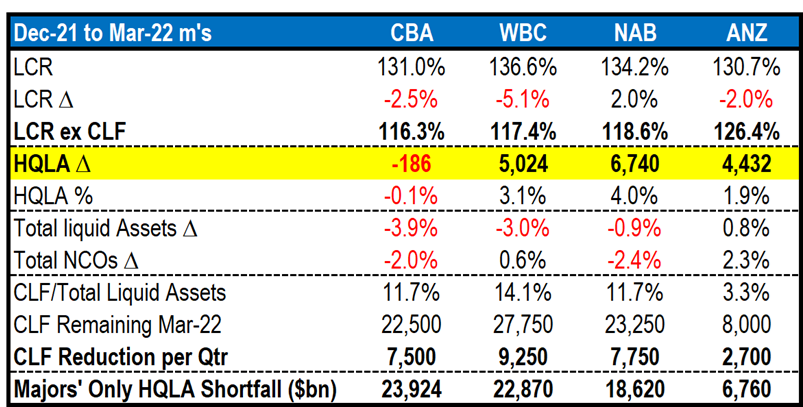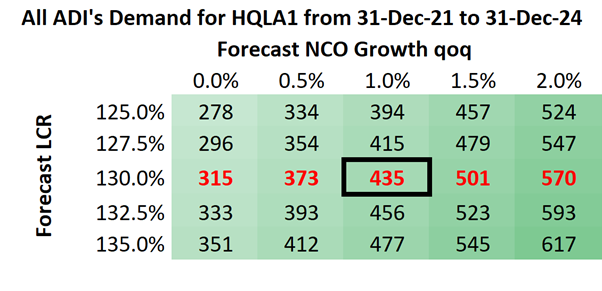Update on Aussie bank liquidity requirements
Following the four major banks reporting their half-year and quarterly results as at the March 2022 balance date, we have updated our estimates of the amount of high-quality liquid assets (HQLA)---or government bonds---that they need to buy by the end of this 2022 calendar year to replace the Committed Liquidity Facility (CLF). We also provide an update of our analysis of the overall banking system's longer-term HQLA requirements based on APRA's latest quarterly ADI and RBA statistics.
Majors' Short-Term HQLA Requirements
The table below summarises the major banks' HQLA needs by the end of CY2022 based on the wind-down of the CLF and the latest March 2022 reporting on the banks' Liquidity Coverage Ratios (LCRs). Excluding the current CLF from the major banks' LCRs, they are sitting at between 116% and 126%. Specifically: CBA (116%); Westpac (117%); NAB (119%); and ANZ (126%). For the major banks to get to their LCRs back to around 130%, they will need to buy about ~$72 billion of HQLA by the end of this year. Adding in all other banks would obviously increase this number materially.

Australian banks, including the majors, have board-mandated LCR targets of between 125-135% due to the enormous volatility of this regulatory liquidity target, which swings around due to changes in the assessed cash-outflows if a one-month "run" were to hit a bank, which is the test APRA imposes. It is not uncommon for a bank's internally reported LCRs to move as much as 20-30% on a single day, which is why across the financial system banks have typically held, on average, LCRs of a little north of 130% as a reasonable buffer above APRA's regulatory minimum of 100%. (Note most banks globally run LCRs of 130-150%.)
In the case of the majors, current LCRs are as follows: CBA (131%); Westpac (137%); NAB (134%); and ANZ (131%). There have been one or two analysts who have speculated that banks might run more regulatory liquidity risk by dropping their LCRs to, say, 120% or 125%, but no banks we have posed this question to have said they expect any reductions in their LCRs. We would also be very surprised if APRA was comfortable with banks taking more liquidity risk, especially given it has recently penalised Westpac, Macquarie (twice), and Bendigo for overstating their LCRs.
Longer-Term Banking System HQLA Requirements
We've updated our estimates of medium-term demand for HQLA based on the latest APRA reporting and RBA balance-sheet data. As a result of (1) the phasing out of the CLF, (2) the repayment of the first tranches of the $188 billion Term Funding Facility (TFF), (3) bond maturities off the RBA's balance-sheet, and (4) growth in bank balance-sheets, we now estimate that Australian banks will need to acquire about $229 billion of HQLA by 30 September next year and $435 billion by December 2024.
The table below shows HQLA demand as a function of the banking system's average LCR and growth in net cash outflows (NCOs), where NCOs normally track bank balance-sheet growth. Given the more than $1.2 trillion in HQLA currently outstanding, and the solid debt issuance expected from the Commonwealth government, and to a lesser extent State governments (see more below), this should be easily achievable.

Recent HQLA Issuance Updates
The AOFM recently advised that the Commonwealth will issue $100 billion of bonds in FY2022 and $125 billion in FY2023 with some upside risk if Labor is elected given reports of expectations of a ~$10bn annual increase in the size of their deficits relative to current Commonwealth forecasts.
The States have also started reporting their budgets. Western Australia has downgraded its debt issuance in FY2023 by a large $1.3 billion (or 20%) compared to its September 2021 budget estimate ($6.4 billion) and by $600m vs its December 2021 estimate.
Victoria announced a $4.5 billion (or 17%) reduction in TCV’s borrowing task for FY2023 compared to TCV’s original $25.8 billion estimate for FY23 issuance in May last year (and the $23.6 billion estimate in December) to $21.3 billion in the latest TCV funding update.
Finally, Northern Territory revealed a chunky $800m reduction in its borrowings expectations for FY2023 compared to the latest estimates published in December 2021.
Like NSW, which is pre-emptively repaying $11 billion of debt, WA is actively repaying $1.2 billion of debt. Victoria also announced it is creating a NSW-style debt retirement fund to be funded by asset sales and future surpluses that will be used for repaying COVID debts. CCI forecasts other states to follow suit and focus on debt reduction as interest rates soar.
2 topics